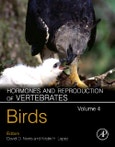This series of volumes represents a comprehensive and integrated treatment of reproduction in vertebrates from fishes of all sorts through mammals. It is designed to provide a readable, coordinated description of reproductive basics in each group of vertebrates as well as an introduction to the latest trends in reproductive research and our understanding of reproductive events. Whereas each chapter and each volume is intended to stand alone as a review of that topic or vertebrate group, respectively, the volumes are prepared so as to provide a thorough topical treatment across the vertebrates. Terminology has been standardized across the volumes to reduce confusion where multiple names exist in the literature, and a comprehensive glossary of these terms and their alternative names is provided.
Please Note: This is an On Demand product, delivery may take up to 11 working days after payment has been received.
Table of Contents
1. Neuroendocrine Control of Reproduction in Birds
Takayoshi Ubuka and George E. Bentley
2. Avian Testicular Structure, Function, and Regulation
Pierre Deviche, Laura L. Hurley, and H. Bobby Fokidis
3. Organization and Functional Dynamics of the Avian Ovary
A.L. Johnson
4. Maternal Hormones in Avian Eggs
Nikolaus von Engelhardt and Ton G.G. Groothuis
5. Stress and Reproduction in Birds
Creagh W. Breuner
6. Hormonal Regulation of Avian Courtship and Mating Behaviors
Lauren V. Riters and Sarah J. Alger
7. Hormones and Regulation of Parental Behavior in Birds
Carol M. Vleck and David Vleck
8. Hormones in Migration and Reproductive Cycles of Birds
Marilyn Ramenofsky
9. Endocrine Disruption of Reproduction in Birds
Mary Ann Ottinger, Karen Dean, and Moira McKernan , Michael J. Quinn, Jr.
Authors
David O. Norris Professor of Integrative Physiology, University of Colorado, Boulder, CO, USA. Dr. David O. Norris (B.S., Baldwin Wallace University, 1961; PhD 1966, University of Washington) was a professor at the University of Colorado for 46 years where he studied environmental endocrinology of fishes and amphibians and taught general biology, endocrinology, human physiology, histology, vertebrate biology, and forensic biology. His endocrine research interests involve the role of natural and anthropogenic factors (pollutants) that operate through the brain and pituitary to influence thyroid, adrenal, and reproductive physiology that in turn affect development, sexual differentiation, reproduction, and aging. He retired from CU in 2012 and currently is Professor Emeritus of the Department of Integrative Physiology.Dr. Norris also does research in forensic botany and consults with law enforcement groups on homicides and other crimes throughout the USA and in several other countries He is a Fellow of the American Academy of Forensic Sciences
Dr. Norris has published more than 150 scientific papers and abstracts in environmental endocrinology and forensic botany and is the senior author on several books including Vertebrate Endocrinology (6th edition, Academic Press, 2020), Endocrine Disruption: Implications for Health of Wildlife and Humans (Oxford University Press, 2005), a five-volume work on Hormones and Reproduction of Vertebrates (Academic Press, 2011) and Forensic Plant Science (Academic Press, 2016). Kristin H Lopez Integrative Physiology, University of Colorado at Boulder, Colorado, U.S.A.. Kristin H. Lopez teaches human reproductive biology through the Department of Integrative Physiology at the University of Colorado-Boulder. With a background in comparative reproduction and endocrinology, she is an editor of the fi ve-volume work Hormones and Reproduction of Vertebrates (Academic Press, 2011). Her ongoing work with Colorado Diversity Initiative promotes increased access to higher education of underrepresented students in STEM.







